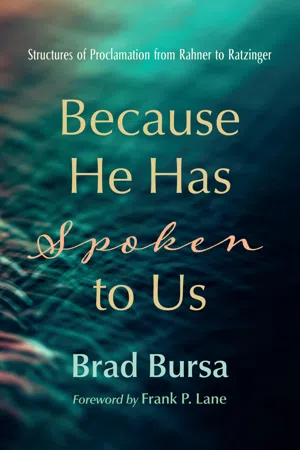![]()
Part I
The Rahner Project: Evangelization and Catechesis after Vatican II
![]()
chapter one
A Rahnerian Blueprint for Catechetical Renewal
Karl Rahner wanted to render mid-twentieth century theology relevant in two ways. First, he sought to make Catholic theology compatible with modern ways of thinking, speaking, and acting. Second, he desired for his systematic theology to impact pastoral ministry in the Church. Regarding the latter, Rahner denounces the thought that theology is an irrelevant and ethereal exercise, instead believing that theology should directly impact the Church’s life and mission and “touch down” in the daily lives of believers. Regarding the former, in the years prior to Vatican II, Rahner saw a need reinvigorate Catholic theology. He, along with many others, believed Neo-scholasticism’s pre-modern propositional approach ossified theology. The dual motivations are in play when he says, “theology must help the preacher preach the gospel in such a way that it can really be understood and assimilated today; [while also having] a critical function . . . in preventing the Church in its preaching or in its practice from becoming a ghetto or sect within the contemporary world.” Hence, Svein Rise concludes, “His writings are characterized by the combination of theory and praxis.” Therefore, one could summarize Rahner’s mission in a rather straightforward manner: Rahner intends to make both theology and pastoral praxis relevant in the face of modernity through correlation by taking postulates drawn from modern thought as his “given.”
In Rahner’s view, Vatican II gave the Church permission to emerge from the ghetto. The Council gave the Church “the courage to face the modern world.” It marked “a real movement away from a more negative, defensive attitude toward a more open and positive one.” He sees this openness as “a positive appreciation of modern culture and of modern science and technology,” with a deeper “awareness of specifically contemporary problems facing mankind today, of the Church’s involvement in these problems, and of her responsibility in helping to find solutions.” Following Vatican II, Rahner, and his Transcendental Thomism becomes a catalyst, indeed the single greatest theological force in Catholicism for advancing this positive relationship between the Church and the modern world.
Rahner’s positive stance toward modernity allows him, like Paul Tillich, to correlate theology and the modern context. According to Tillich, in the correlation method, “systematic theology proceeds in the following way: it makes an analysis of the human situation out of which the existential questions arise, and it demonstrates that the symbols used in the Christian message are the answers to these questions.” Peter Harrison describes the goal of correlation theology as showing how the Christian message encounters questions implicit in a situation, in a human experience. Rahner takes up correlation as a useful tool for stirring up a stagnant theology, and describes the characteristics of his theological project as being:
•Pluralistic: Rather than a singular, homogenous theology for the whole Church, as there had been for nearly a century with Neo-scholasticism, Rahner calls for a plurality of theologies that express the richness, universality, and diversity of the Church.
•Missionary and Mystagogical: This theology must be missionary in that it serves a faith rooted in personal conviction, and mystagogical in that it brings what the Church believes (fides quae) into close unity with the personal act of faith (fides qua) so that what the tenets of the faith mean concretely for the individual and society are clear.
•Demythologizing: Transposing and expressing the faith in such a way that it can be assimilated by contemporary people. Rahner adds, “We are and shall always be bound to tradition, of course, but the tradition is the beginning, not the end of theology.”
•Transcendental: Theology will highlight the role of the knowing subject.
In sum, Rahner attempts to bring theology to life by injecting it with the thought of modernity, and by attempting to show how theology correlates to modernity. As a result of Rahner’s openness to modernity, John Milbank describes the main thrust of Rahner’s theology as a movement “toward a universal humanism, a rapprochement with the Enlightenment and an autonomous secular order,” which became, as Rowland notes, the point of departure for many of the liberation theologians of the 1970s and 1980s.
At the bottom of it, Rahner’s modern project attempts to seriously engage the “Heideggerian problematic.” Connor Sweeney explains that Heidegger accuses metaphysics “of imposing an a priori interpretive grid over top of temporality and historicity, and thereby determining in advance the interpretation of Being in time.” “In essence,” Sweeney says, “Being is no longer able to reveal itself as Being in any given historical epoch because it’s [sic] meaning has already been artificially established in advance.” Sweeney points out that Heidegger and his followers accuse onto-theology of a certain numbness to the phenomenon, because in their effort to attain to the essenc...
